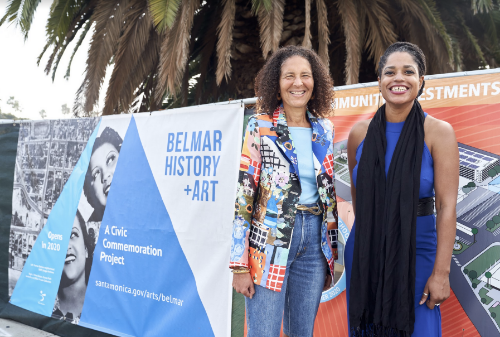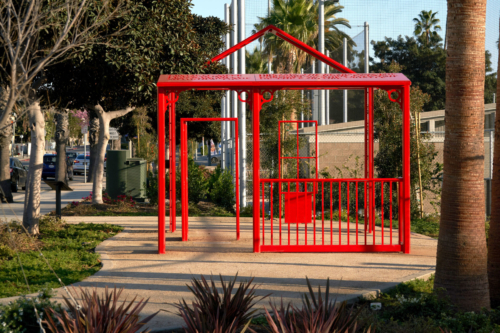Belmar Neighborhood
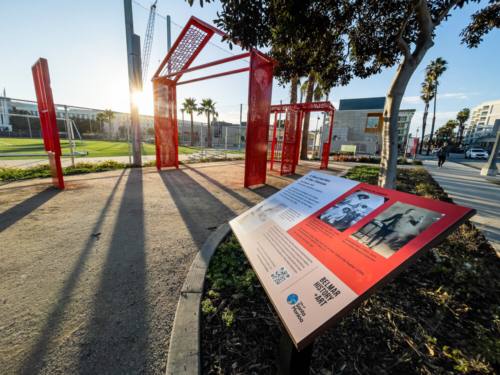
- Known As
- Belmar Triangle
- Architect
- –
- Built
- –
- Designated
- –
From the 1880s to post-World War II, many African Americans came from southern states to escape the worst of racist anti-black restrictions during the Jim Crow era (1900–1960s). They migrated west alongside immigrants, lured by advertisements of the manifold benefits of Southern California: employment, good climate, health, beautiful landscapes and a more liberated lifestyle.
African American families settled in clusters in South Santa Monica beach neighborhoods, around Phillips Chapel Church in Ocean Park, in the Belmar Place area where the Civic Auditorium stands south of Pico Boulevard to Main Street, and in another neighborhood north of Santa Monica High School (SaMoHi), east of Fourth Street. These Santa Monica neighborhoods were home to the oldest African American settlement in any seaside community in the region. Located just blocks from Bay Street Beach, Black residents could enjoy themselves with minimal racial harassment.
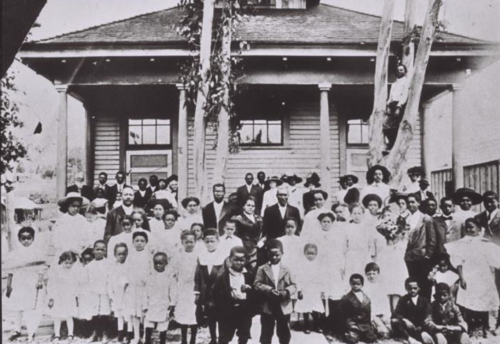
Original Phillips Chapel building with CME Sunday School Convention of the Los Angeles District in front, 1909. Photo: Santa Monica Public Library Image Archives
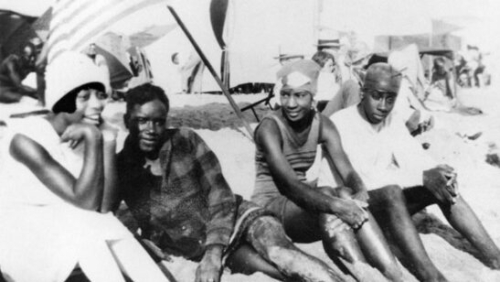
Beachgoers Grace Williams, Albert Williams, Mary Mingleton and Willie Williams at the Bay Street Beach, 1926. Photo: Shades of L.A. Photo Collection/Los Angeles Public Library
Most of the early Black migrants worked in domestic and service employment, while a few became small business entrepreneurs. The Belmar Triangle was a particularly important area where Black businesses owners provided services to the Black community. La Bonita Bathhouse and Café (1811 -1825 Belmar Place or what is now the eastern edge of the Civic Auditorium) served customers from the 1910s-50s. The Arkansas Traveler Inn (Belmar Place and Trolleyway, or what is now Main Street) accommodated Black tourists in the 1930s, and Everybody Cafe (408 Pico Blvd) served beachgoers in the 1930s. Medical and dental practices also operated in the 1930s-‘40s on the 400 block of Pico Blvd.
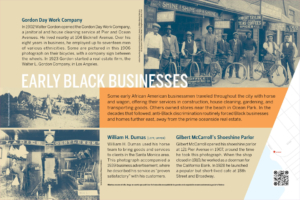
One of a series of exhibition panels developed by Alison Rose Jefferson PhD for the Belmar History + Art public art project.
As in other parts of the country, Santa Monica’s early African American residents lived, worked and found happiness as they took action to end oppression and discrimination and dismantle racial barriers when California’s civil rights laws (passed as early as 1893) were not enforced.
The African American neighborhood thrived in the Belmar Triangle until the 1950s when it literally went up in smoke in the name of urban renewal. The land was taken away by eminent domain to make way for the City’s expanded Civic Center, which included an Auditorium and the Los Angeles County Courthouse. The City burned down homes and businesses both rented and owned by African Americans and other marginalized groups.
The demise of the neighborhood north of SaMoHi and the Belmar area was part of a national program by the federal government to fund interstate highway building and cities in an effort to “clean up” impoverished areas and keep them economically viable for the City. These urban modernization efforts were part of a campaign to encourage white upper- and middle-class people to visit and continue to reside in the bay city. An estimated 80% of those who were displaced nationwide were African Americans and people from other marginalized groups. Little was spent on their relocation.
Similar destruction was echoed in Los Angeles’ Chavez Ravine and east of downtown where largely Mexican American neighborhoods were decimated. Though the government acquired the land at Chavez Ravine to build public housing, it never materialized. Dodger Stadium was built instead. The east of downtown neighborhoods were destroyed by the construction of freeways that cut through them.
“That huge mushroom cloud in the sky this morning wasn’t an atomic explosion – it was only the city’s way of beginning the ‘Build America Better’ cleanup campaign” that resulted in the Civic Auditorium, the L.A. Courthouse and assorted parking lots,” noted a Santa Monica Evening Outlook newspaper report.
In 2019 the City of Santa Monica embarked upon the Belmar History + Art project, a celebration and commemoration of the historical African American experience around the Belmar and surrounding neighborhoods of Santa Monica. As a condition for the construction permit for the sports field at the Historic Belmar Park, the California Coastal Commission required that a historical interpretation and educational program be developed to remember the legacy of the Black community that was displaced and that survives in other places in the bay city today.
Santa Monica Cultural Affairs worked with a community advisory committee consisting of members with deep roots in Santa Monica’s Black community to help guide the development of the project. Alison Rose Jefferson, Ph.D., author, historian and Conservancy member, was contracted to provide historical background on the neighborhood and assist in the production of educational materials. Dr. Jefferson worked with social practice artist April Banks, who created a community engagement program that, in conjunction with Dr. Jefferson’s research, led to a permanent sculpture and history exhibition comprised of sixteen interpretive panels at the newly named Historic Belmar Park.
Banks’ artwork, titled “A Resurrection in Four Stanzas,” depicts four architectural aspects of a shotgun house, rendered in metal at full scale. This was a residence type which was and remains part of the urban landscape in the South Santa Monica Beach neighborhoods. Accompanying the outdoor installation of Belmar History + Art project is the City’s Belmar History + Art website, which hosts educational resources around the project.
Dr. Jefferson also created an essay titled “Reconstruction and Reclamation: The Erased African American Experience in Santa Monica’s History” which is an outgrowth of her book, Living the California Dream: African American Leisure Sites during the Jim Crow Era. This essay includes never before published stories of African American families, events, and places in the South Santa Monica Beach neighborhoods before 1960 and more info about both are available at her website.
A virtual grand opening celebration for the park was held on February 28, 2021.
Sources:
Banks, April. www.aprilbanks.com
Dixson, Brennon, “Belmar History + Art Project Sculpture Designs Approved and Revealed,” Santa Monica Daily Press, July 18, 2020.
Historic Belmar Park, “Historic Belmar Park.”
Jefferson, Alison Rose, “Belmar History + Art, A Santa Monica Commemorative Justice Initiative Continues Rolling Out 2020-2021,” Blog Post, Updated July 15, 2022.
Jefferson, Alison Rose, Living the California Dream: African American Leisure Sites during the Jim Crow Era, 2020. alisonrosejefferson.com
Williams, Ann K., “Frank Gruber to Shine Light on Lost Belmar Triangle,” The LookOut News, September 29, 2011.
